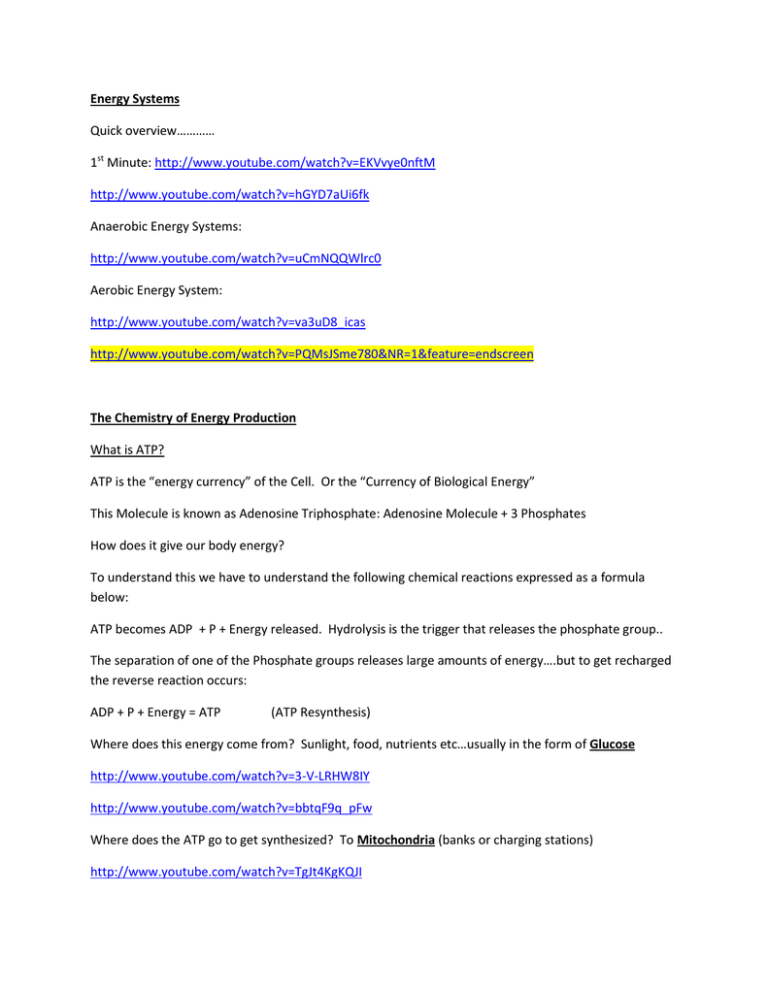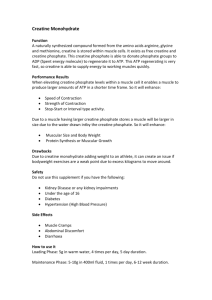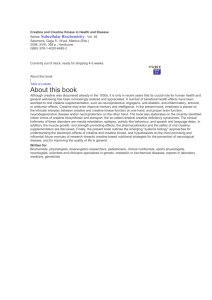Energy Systems Quick overview………… 1st Minute: http://www
advertisement

Energy Systems Quick overview………… 1st Minute: http://www.youtube.com/watch?v=EKVvye0nftM http://www.youtube.com/watch?v=hGYD7aUi6fk Anaerobic Energy Systems: http://www.youtube.com/watch?v=uCmNQQWlrc0 Aerobic Energy System: http://www.youtube.com/watch?v=va3uD8_icas http://www.youtube.com/watch?v=PQMsJSme780&NR=1&feature=endscreen The Chemistry of Energy Production What is ATP? ATP is the “energy currency” of the Cell. Or the “Currency of Biological Energy” This Molecule is known as Adenosine Triphosphate: Adenosine Molecule + 3 Phosphates How does it give our body energy? To understand this we have to understand the following chemical reactions expressed as a formula below: ATP becomes ADP + P + Energy released. Hydrolysis is the trigger that releases the phosphate group.. The separation of one of the Phosphate groups releases large amounts of energy….but to get recharged the reverse reaction occurs: ADP + P + Energy = ATP (ATP Resynthesis) Where does this energy come from? Sunlight, food, nutrients etc…usually in the form of Glucose http://www.youtube.com/watch?v=3-V-LRHW8IY http://www.youtube.com/watch?v=bbtqF9q_pFw Where does the ATP go to get synthesized? To Mitochondria (banks or charging stations) http://www.youtube.com/watch?v=TgJt4KgKQJI Draw a Picture of an Adenosine Triphosphate Molecule Now Draw a picture of an Adenosine Diphosphate Molecule with detached Phosphate group and Energy + Phosphate Group + Energy Release This diagram explains the Cycle of Cell Respiration Answer Theory of Knowledge Questions 1) and 2) Discuss Ethical Concerns in relations to research in Animals. Ethical: about moral philosophy, from Greek word “ethos” or Character. What are you concerns, if any, about using animals in research? - Good: helps find medical treatments - Bad: animals killed - natural to kill animals to eat - Animal has use as food not as testing subjects - Experiment on animals for cures is good or okay – people testing on animals have respect for them. If you experiment on them, don’t let them suffer - People, dogs, mice okay to test on - Different opinions depending on where you are from (China vs. USA) Justify the relevance of knowledge gained from experiments with rodents to the human metabolism. - Foods effect - Similar to humans - Less mental stress Can research from rodents help explain our metabolism, or even save human lives? Use I-pads and Computers to research and answer. Anaerobic Energy Systems: Immediate Energy: The High Energy Phosphate System or Creatine Phosphate System When you first start intensive physical activity, such as a sprint, you need energy right away. This is provided by Creatine Phosphate (CP) which, when broken down, bonds with ADP to reform ATP. You may see this also expressed as the ATP-PC System. There is only a small amount of ATP and CP stored in muscle Fibers so this system can only operate for the initial 7-12 seconds of a high intensity activity. This is why a 100M runner tends to slow down after about 8-9 seconds. Also after a set of 10 reps in the weight room at 80% of Max, the ATP diminishes rapidly. http://www.youtube.com/watch?v=QxbV77BuUwc Short Term Energy: The Lactic Acid System This second system can produce ATP but at the expense of producing Lactic Acid as a by-product. Using a process known as “Anaerobic Glycolysis”. This is a complex chemical reaction that ends in the production of a compound called Pyruvate. When the rate of work is High, Pyruvate is converted into Lactic Acid, which, when it accumulates in the blood, leads to an Anaerobic Threshold. http://www.youtube.com/watch?v=3FujDiyKMiw At this point the athlete feels discomfort in the muscles and in the 400m meters for example the athlete will experience “rubber legs”. Appropriate training can increase the Anerobic Threshold. (Lance Armstrong doing Lactate Testing) http://www.youtube.com/watch?feature=fvwp&v=1QcIHRUELuY&NR=1 AEROBIC ENERGY SYSTEMS: Long Term Energy: The Oxygen System Used for most daily activities and longer duration physical activities and sports. In the aerobic system, a complex chemical reaction known as OXIDATIVE PHOSPHORYLATION is used to resynthesize ATP. This takes place in Cell organelles called Mitrochondria. A metabolic process there called the KREB’s Cycle breaks down Pyruvic Acid, including other fuel sources such as Glucose Fat and Proteins. http://www.youtube.com/watch?v=WW9ZH_FBu18 So to break this down into manageable and understandable parts let’s look at the process this way: Cellular Respiration though the Aerobic process happens in three stages: 1. The First Stage is called Glycolysis and occurs in the Cytoplasm. In this stage Glucose molecules get split into two and enter the Mitochondria where the second and third stages occur. 2. The second stage, The Krebs Cycle, (preceded by a prep step) is a series of reactions that occur in the Mitochondria. This is also called the Citric Acid Cycle. 3. The third stage also takes place in the Mitochondria (specifically the inner folds called the Christae) and is called Electron Transport System/Chain, and involves a series of enzymes called the ETC. Chemeosmosis is the process in this last stage that produces the ATP. http://www.youtube.com/watch?v=g44wSRU5LXY http://www.youtube.com/watch?v=i8c5JcnFaJ0 first 8:20 minutes – excellent graphics The final result is that 36 ATP molecules are produced from this overall process. Split up into groups of three. Each choose one of the three energy systems. Spend some time to understand that system. Take turns explain to the other two how each system works and which sports would primarily use that system. VO2 Max vs. Lactate Threshold http://www.youtube.com/watch?v=lv7Vls3rN0I Creatine: what is it and how can it affect strength and power? Creatine (produced in the body as Creatine Phoshate) is naturally produced in the human body from amino acids primarily in the kidney and liver. It is transported in the blood for use by muscles. Approximately 95% of the human body's total Creatine is located in skeletal muscle. Creatine helps to supply energy to all cells in the body, primarily muscle. This is achieved by increasing the formation of adenosine triphosphate (ATP). The use of Creatine Monohydrate (CrM) as an athletic supplement is based on the physiological presence of Creatine (Cr) and Creatine Phosphate(PCr) in skeletal muscle, where PCr acts as a minor store of high energy compounds, which may rapidly but only transiently be recruited to replenish the depleted energy stores in vigorously contracting muscles. The CrM supplement theory postulates that, by increasing the concentration of Cr in skeletal muscle, CrM will allow muscle to achieve a higher anaerobic threshold and to undergo higher intensity training. Creatine is a non-essential amino acid that is formed in the liver, pancreas and kidney and also consumed in the diet from the ingestion of animal products. Cr has the ability to bind a high energy phosphate, forming PCr. During high intensity exercise, muscle drains its adenosine triphosphate (ATP) stores. PCr donates its high energy phosphate to adenosine diphosphate (ADP), leading to the re-synthesis of adenosine triphosphate (ATP). Thus, PCr acts as a short-term energy buffer during periods of rapid ATP turnover. The system is high power (large amounts of ATP may be produced) but low capacity (storage amounts are normally drained in less than 20 seconds), thus fitting a role in anaerobic activity We know that Creatine Phoshate is used in the Immediate Energy System but is it a “magical compound” that can be supplemented artificially? Pair up. Do some research on Creatine Products. List them and list their suggested benefits. Also list any side-effects that they might have. One of you take the opinion that Creatine is harmful and is a marketing gimmick. The other take the opinion that it is a safe and useful way to create more power and strength. Back up your findings with research. We will have a class discussion on this subject to discuss all opinions and findings. Creatine: Advantages Disadvantages Builds Muscle – increase power lifting Can make a person feel and look Bloated* Medical Uses – heart failures, ALS Possible Liver and Kidney Damage* Bone mass increase* Can increase asthmatic symptoms* Decreases Muscle fatigue* Cause dizziness, muscle cramps, stomach upset* Repairs Muscle Tears quicker* Not good for jumping events or weight class events* Helps deliver more testosterone* Time lag – not immediate benefit Most effective in High Intensity sports Creatine overload (can raise levels 9 X) Possibly reduce Cholesterol Costs Money – up to 50 dollars for a jar *From a medical source http://www.youtube.com/watch?v=BR3dDO1Sz0E http://www.youtube.com/watch?v=Bwyn0v987Kg Best Medical Source and Debate description: The International Society of Sports Nutrition http://www.jissn.com/content/4/1/6 Benefits There have been many studies conducted to determine the effects of creatine supplementation. Almost all of these studies report positive results. There seems to be no doubt that creatine supplementation improves athletic performance during intense, short-duration exercise. A strength training study conducted at the University of Memphis showed a group of football players increased their 1-RM bench press (the maximum amount of weight lifted in one repetition) by an astounding 100%. This study was conducted following a loading phase of 1 week and a maintenance phase of 4 weeks. 40-yard dash times also showed significant improvements. In a study on competitive swimmers, 100-meter sprint times were decreased by almost a full second! University of Toronto showed that competitive cyclists improved their endurance during high-intensity cycling by around 10 percent. Other studies have shown improvement is body composition (more lean muscle mass, less body fat) and overall strength. Risks No direct adverse reactions or side effects have been documented in any studies or reports on creatine supplementation. There have been "unofficial" reports of intestinal gas, nausea, muscle cramping and weight gain. Studies have shown no consistent reports of any of these side effects. A weight gain of 2 to 5 pounds, during the loading phase, appears to occur on a fairly regular basis, which usually disappeared within 7 days after the loading phase is discontinued. Continued supplementation of creatine appears to decrease the natural synthesis of creatine in your body. This condition appears to reverse itself after supplementation is discontinued. However, the jury is still out on this, so long term use should definitely be avoided. Creatine supplementation has been shown, through various studies, to be safe. More research is needed to determine long-term effect of supplementation. At this point, however, there are no signs of ill effects from dietary supplementation. One risk that needs to be taken into consideration is the effect on the body’s ability to produce creatine naturally. No long term studies are available that address this potential risk. Short term use, according to directions, appears to be safe. At this time, long term use is not recommended. Any excessive use or any use that does not follow the manufacturers’ directed use is dangerous and should not be undertaken. Is it doping? There is some controversy concerning the ethics of using creatine to improve athletic performance. Doping has most recently been defined as anything that is harmful to an athlete's health or artificially augments the athlete's performance. Creatine is not currently classified as a banned substance, however arguments have been made that is a pharmacological performance enhancer and should be considered unethical. The opposite argument is that creatine supplementation is no different than carbohydrate loading. Both involve the ingestion of more than the normal amount of a naturally occurring substance. Creatine supplementation is not currently considered doping and is a legal substance. Conclusion: The use of creatine supplementation continues to be a hotly debated and relevant topic for health care professionals, amid its widespread use among young people and the mass of research with inconclusive or questionable outcomes. While the argument that creatine is an effective anaerobic ergogenic aid has a wealth of evidence, the case for the safety of its long term use does not. This fact is worrisome given the cavalier manner in which many use the supplement, as considerations of genetic predispositions to kidney disease, underlying occult or known disease states, or even metabolically competing medications are often excluded from the decision of whether, how much and for how long to use the creatine supplement. While evidence to date does not suggest a widespread pattern of severe side effects from its use, the research is silent regarding risks in the context of disease, such as impaired glomerular filtration. In an era where the burden of proof lies with the health care professional, who operates under the principle of evidence based medicine, physicians should work to communicate this lack of clarity, to urge caution and to demand more comprehensive research. DEBATE: Premise: Creatine is a perfectly safe way to build extra muscle and increase energy levels Counter Argument: Creatine is a marketing gimmick that can be harmful to one’s health. OXYGEN DEBT: What happens when you have just finished an explosive event – such as wind sprints, or you get rotated from a Hockey game, or you just made several long runs in a soccer game? How are you breathing then? How long does it take to recover? When you have a short intense burst of exercise such as sprinting you generate energy for this anaerobically or without oxygen. When you stop exercising you are still breathing heavily. This is your body taking in extra oxygen to 'repay' the oxygen debt, OR POST EXERCISE OXYGEN CONSUMPTION (EPOC) Ultimately, once adequate oxygen is available, lactic acid must be converted completely into carbon dioxide and water. After exercise has stopped, extra oxygen is required to metabolize lactic acid; to replenish ATP, phosphocreatine, and glycogen; and to pay back any oxygen that has been borrowed from hemoglobin, myoglobin (an iron-containing substance similar to hemoglobin that is found in muscle fibers), air in the lungs, and body fluids. The additional oxygen that must be taken into the body after vigorous exercise to restore all systems to their normal states is called oxygen debt. Task: Think of some training sessions you may have done with your team, your coach, individually or as a group to address Oxygen Debt. Write down some exercises or training ideas that you think might improve our ability to recover from Anaerobic work…………… we will share these with the group.


